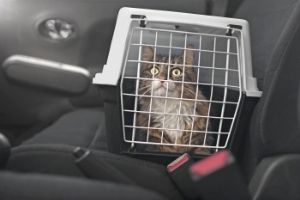Getting your cat in a carrier and taking them to the vet can be incredibly stressful for both of you. It's extremely common for cat owners who adore their cats to only take their cat into the vet when they are sick because it will stress their cat out. The big problem is that cats will try to hide their symptoms until they fall critically ill. If your feline family member does develop health issues and we can detect it early, the issue is more likely to be treated and resolved. With early detection, treatment is more likely to be less expensive and easier to manage. This likelihood decreases if we only see our feline patients after they have started showing symptoms.

Regular Wellness Visits Are a Must
Your beloved feline friend needs routine wellness visits so that you can have better and longer lives together. We do this by preventing health issues and detecting problems in their early stages. La Cumbre recommends yearly annual exams as a preventative measure so that our feline patients achieve and maintain optimal health. We do understand that pet parents are not always inclined to bring their cat in for wellness exams even when they consider their cat’s health to be a top priority. It is especially understandable if your cat fights you every step of the way and both of you are at max capacity for stress before, during, and after a visit. But in order for you to have a longer and better life with your cat, they need to come in regularly. Annual wellness exams also allow our vets to approve prescriptions and see your cat sooner if they do get sick.

Why Early Cat Illness Detection is Key
Imagine if the only time you took your cat to the vet is when they're sick and they have to come in - no matter what. They already feel horrible and now they've been forced into a carrier, potentially for the first time since they were brought home with you! They're then taken on a noisy care ride, where they are being bounced around, and then they're brought to a new place that has different smells and different people who are doing strange things to them. There is no place for them to escape and they are feeling all these new sensations all at once. This ordeal can feel like an abduction to your cat and puts them into fight-or-flight!
When your cat is in "get me outta here/escape mode", it creates a lot of extra stress that neither of you needs, especially when they have an illness or disease. This can make things even more difficult (if not impossible!) the next time. The goal is to reduce stress wherever possible so that a situation doesn't escalate. This can be accomplished with positive reinforcement and conditioning.

How Can I Get My Cat to the Vet Without a Struggle?
It can take time, ingenuity, and work, but it is possible! Your cat may never “enjoy” going to the vet, but there are many opportunities to try to continually decrease your cat's anxiety and stress with each visit. This will help your cat to become adjusted to going to the vet on a routine basis for wellness appointments and for visits when they are under the weather. We want them to know what to expect, to be somewhat familiar with a certain level of change, and to maybe even understand that it is only temporary.
The way to move toward an easy vet visit for your cat is to eliminate as many stressors as possible. You want your cat's stress and anxiety minimized to the point where getting your cat to the vet is manageable and routine.
Why Do I Need a Carrier?
The first indication that your cat knows something is up is when you bring out the carrier. It is of the utmost importance to bring your cat to the vet in a proper carrier. From your car to the exam room, there are way too many devastating possibilities. Allowing your cat to roam in your car unsecured means that they can easily get under your feet and potentially cause an accident. If you're in the parking lot and your cat flips the switch to fight-or-flight mode, they could get loose and escape into unfamiliar territory and end up lost forever.
If you actually make it into the building, barking dogs and unfamiliar smells can terrify your cat and don't make them easy to hold. By the time you get into an exam room, your cat has worked itself into a state where no vet or vet tech can touch your sick cat to examine, assess, and administer any necessary treatment.

What Kind of Carrier Should I Get?
When choosing a carrier, the functionality should be your deciding factor. You want to select a carrier that is sturdy, stable, and easy to carry. To ensure that the car ride is as smooth as possible, the carrier needs to be able to be with a seatbelt so that it is snug and stable. The best carriers are the sturdy plastic ones that open from both the front and the top. The top and bottom should come apart so that it is possible to examine your cat by removing the top and allowing them to remain in the bottom if they are stressed out, in pain, or scared.
Avoid carriers that will make it more difficult to get your reluctant cat out of the carrier so that they must be dumped or pulled out to be examined.
Create a Safe Carrier Haven
Cats can sense our anxiety or frustrations, which may cause them to become stressed and reluctant themselves. Start this process a few days ahead of your appointment, as this will take time. Leave the carrier out in the open where your cat spends most of their time. Make the carrier your cat’s retreat: place some toys, familiar bedding, or an item of your clothing that has your scent inside of the carrier. Include treats or catnip and check to see if they have been eaten or moved around. Use pheromone sprays such as Feliway (available for purchase at our office!) These sprays mimic natural feline scents that trigger cats to feel comfortable and secure. The goal is for your cat to learn to associate the carrier with positive experiences and to go inside of it on their own. This can take a couple of days or even weeks. If it doesn't work, you may need to try a different carrier.
Important note: never scold or punish your cat. It does not work and will likely have the opposite effect. Remain calm, patient, and reward desired behaviors frequently. For example, if your cat goes in and out of the carrier or even stands next to the carrier, give a reward! A reward does not have to be a treat. Use whatever motivates your cat the most. It can be petting, brushing, or treats.
Looking for more tips on how to make your cat's trip to the vet stress-free? Give us a call.
